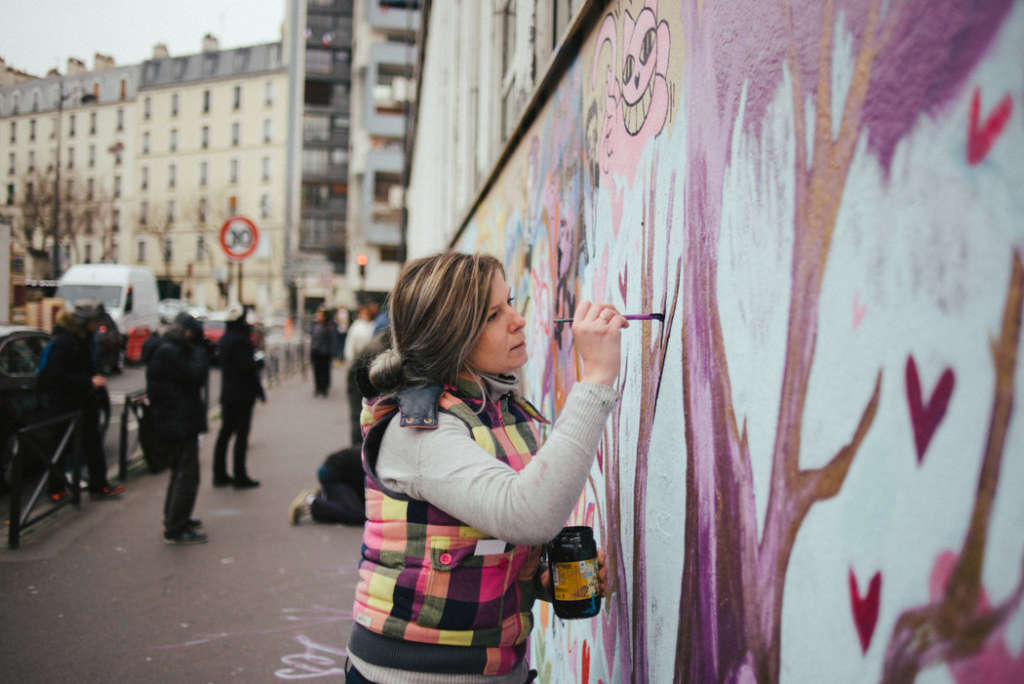By: Martina Bellisario and Donato Paolo Mancini
In an effort to heal their neighborhood, residents of the ‘10th Arrondissement’ invited street and graffiti artists to paint on a block-long wall near two cafes that were attacked.
A self-described “pop graffiti” artist from the Parisian suburb of Villeparisis, Mr. Di Bona felt that it was important for him to paint the mur de l’amour, even though he knew it would be a painful experience.
For the wall, Mr. Di Bona, 40, adapted Eugène Delacroix’s 1830 painting “Liberty Leading the People.” The figures in his painting are almost faceless, the details of their expressions intentionally obscured so that the image could “represent all French people.”
“From start to finish, I was thinking about all the people who died just near here,” Mr. Di Bona said. Bishopparigo, a street artist and friend, “was near me, but we didn’t speak to each other,” he said. “All day we were painting and concentrating.”
“I was really afraid, and I felt all alone,” Diana Kami, an artist who lives in the 10th Arrondissement with her daughter, said of the Nov. 13 attacks in Paris that left 130 people dead, many in her neighborhood. The next Monday, after dropping her daughter at school, she was overwhelmed by a desire to make art.
Almost instinctively, she said, she began to paint on a wall along rue Alibert that is often used as a canvas for local street artists – and is just steps from Le Petit Cambodge and Le Carillon, two cafes targeted in the attacks.
Several mothers from her daughter’s school, just on the other side of the wall, took notice of Ms. Kami’s work and requested permission from the local government to paint the entire wall.
“We wanted to do something,” said one of them, Gaelle Giffard, who crowdfunded 500 euros from the neighborhood to cover the cost of paint.
The result is “Dessine-Moi un Bouquet,” a communitywide initiative that invited street and graffiti artists, as well as local residents and children, to cover the wall with images in response to the attacks.
One mother told Ms. Kami that the wall, nicknamed Le Mur de l’Amour, or wall of love, has had a calming effect so that she is no longer afraid to walk in the street. An elderly man told Ms. Kami that simply watching her paint helped him find peace.
For her own contribution, Ms. Kami painted a forest of trees, their branches outstretched. “In nature, the hunter protects himself in the forest,” she said, “and the tree is life. It’s to protect the neighborhood.”
Mr. Novo, 51, a longtime resident of the area, painted “Radiant Mother,” an image meant to give hope to survivors and mend “the shock and trauma of that night.” He also sought to send a message that “we are all children of France — secular and ethnically diverse France.”
Through his portrayal of historical and culture figures like the Rev. Dr. Martin Luther King Jr., Rosa Parks, Nina Simone and Bruce Lee, Mr. Novo constructs a message of unity in times of uncertainty and prejudice. He uses live painting as a tool to communicate with bystanders, sometimes provoking reactions that, he says, “are not always necessarily positive.”
Mr. Novo often interrupts his work to discuss his past as the son of Cambodian and Vietnamese immigrants and what led him to become an artist. He sometimes paints for young people in the suburbs, or ethnically diverse inner suburbs. “The things they go through, I went through, too,” he said.
Gérard Laux, a 62-year-old retired printing worker who paints under the name Mosko, said he had avoided referencing the Charlie Hebdo attacks of January 2015 in his art, worried that he would be perceived as seeking to profit from cultural trauma.
But on rue Alibert, he said, “I see this wall with the kids’ drawings, full of life” and realized that his own paintings of bright, delicately detailed animals seemed to make sense beside the joyfully uninhibited designs of children. “The expression of my animals is really quite soft,” he said. “It’s not aggressive, so I think it’s effective on the wall.”
Mosko chooses to paint by daylight, meeting people in the street as he works. In this way street art has the power to open people up to one another, he added, and “in a really tragic period, we need this.”

